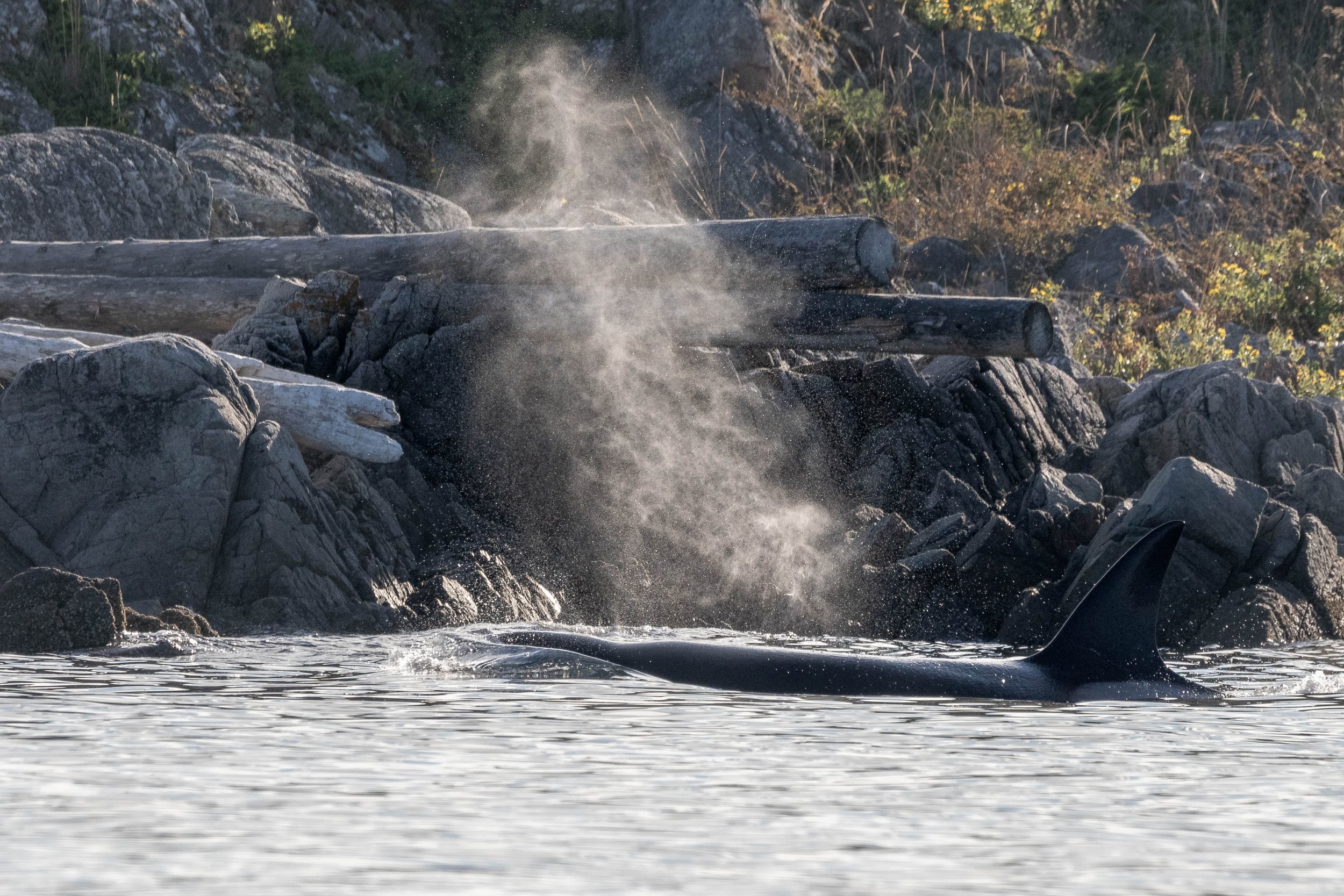September 12, 2024, 3:30 pm - Hunting with the T002Cs and T075Bs and seeing the T019s in the Strait
Setting out from the docks in Nanaimo this afternoon, we were met with an unusual certainty: we had a plan in place. As any seasoned whale watcher knows, these journeys often start without a clear direction, as the whales in the area are not tagged. This means we rely heavily on live reports and keen observation, making each outing a fresh and unpredictable start. But today was different—a shore-based report had come in about a pod of orcas not too far from our position. With this intel in hand, we set our sights on heading north into the Strait of Georgia, toward the Winchelsea Island Archipelago, where our first encounter would unfold.
Upon arrival in the archipelago, we were fortunate enough to find two transient orca pods, the T002Cs and the T075Bs. Biggs, aka Transient, orca are known for their specialized hunting techniques, targeting marine mammals such as Harbour Seals. Our timing couldn’t have been more perfect: we had stumbled upon a live hunt.
T002C Tasu ♀ (1989)
T002C1 Rocky ♂ (2002)
T002C3 Lucy ♀ (2011)
T002C5 (2020)
T075B Pebbles ♀ (1995)
T075B2 Jasper ♀ (2015)
T075B3 Rubble ♂ (2017)
T075B4 (2021)
The orcas were in pursuit of a young Harbour Seal, whose survival instincts were being tested in a high-stakes game of cat and mouse. The speed and coordination of the orcas during such hunts are nothing short of remarkable. However, this seal proved to be particularly elusive. Midway through the chase, it sought refuge on a rocky outcrop, a temporary sanctuary from its formidable pursuers. While we couldn’t stay to witness the outcome, the encounter gave us a fascinating glimpse into the behaviour and strategies of these apex predators.
With the excitement of the hunt behind us, we decided to venture further into the Strait of Georgia in search of more wildlife. Our perseverance paid off when we came across another pod: the T019s! Unlike the T002Cs and T075Bs, this pod was more dispersed, travelling quickly through the water and performing long, deep dives.
T019 Nootka ♀ (~1965)
T019B Galiano ♂ (1995)
T019C Spouter ♂ (2001)
The T019s are well-known among orca enthusiasts, and despite the challenge of observing them in such conditions, it was thrilling to see one of our favourite pods in action. Their behaviour suggested they were on the move, potentially searching for prey or simply covering ground in their wide-ranging territory. Viewing was tough as they dove for extended periods, but the occasional sight of their dorsal fins breaking the surface was a reward in itself.
As our time on the water drew to a close, we made a final stop at a Harbour Seal haul-out. Here, a group of seals rested peacefully, unaware or perhaps indifferent to the drama that had unfolded earlier in the day. These seals, lounging on the rocky shores, provided a sharp contrast to the young seal we had seen evading the orcas during the hunt.
Haul-out sites are critical for Harbour Seals, offering them a place to rest, thermoregulate, and avoid predators, though orcas are never too far from their minds. Watching these calmer, more relaxed seals was a fitting way to end our day, a reminder of the balance between predator and prey in this dynamic marine ecosystem.
The journey today was a vivid reminder of the interconnectedness of life in the Strait of Georgia—from the orcas to the seals, every animal plays a role in this marine ecosystem. And while the orcas may have been the stars of the show today, the survival instincts and resilience of the Harbour Seals are just as captivating.
As we conclude the day, we can only wonder what tomorrow will bring on these untamed waters. Please enjoy the photos taken by Marine Naturalist Vanessa Vereschahen below!
T002C1 Rocky surfacing in the islands.
T002C1 Rocky right along shore of one of the small islands.
T002C1 Rocky with his blow backlit.
T002C Tasu patrolling the shoreline.
T002C1 Rocky with T075B4 just behind him, closer to shore.
T002C1 Rocky steals the show with his massive dorsal fin.
T075B Pebbles, T002C Tasu, and T002C1 Rocky surfacing together.
T075B2 Fifi surfacing with T075B Pebbles.
T075B Pebbles with another just breaking the surface.
T075B Pebbles and the other showing the top of its head.
A great look at T075B Pebbles' saddle patch.
T002C Tasu has this notch at the bottom of her dorsal, making her easy to ID.
T002C5 in front of mother, T002C Tasu.
T002C1 Rocky.
T075B3 Rubble.
T002C1 Rocky has a lot of scarring on his saddle patch.
T002C Tasu.
A big blow from T002C1 Rocky.
Can you spot the harbour seal sheltering on the rocks in this photo?
There it is!
T002C Tasu during the hunt. There's another frightened seal in the background.
T002C Tasu and T002C5 surfacing together.
T075B Pebbles along shore.
T002C1 Rocky in the sunshine.
T075B2 Fifi surfacing in the sun.
T019C Spouter has a dent in his dorsal fin.
T019C Spouter surfacing in the Strait.
T019C Spouter.
T019B Galiano has a very distinct dorsal fin.
A Rhinoceros Auklet swimming by.
Some Harbour Seals at the haul out as the sun sets.































